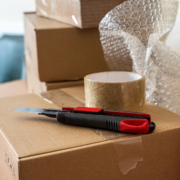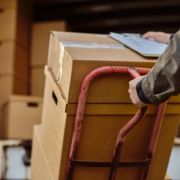How to Pack Lamps for Moving?
/in Moving News & Advice/by ManagerHow to pack lamps for moving? Moving can be a daunting task, especially when it comes to packing fragile items like lamps. Properly packing your lamps ensures they arrive at your new home safely, without any damage. In this guide, Cheap Movers Costa Mesa provides valuable tips on how to pack lamps for moving, ensuring a smooth and stress-free relocation process.
How to Pack Lamps for Moving?
1. Gather Packing Supplies: Before you start packing, gather the necessary supplies, including sturdy moving boxes in various sizes, packing paper, bubble wrap, packing tape, and a marker for labeling.
2. Disassemble the Lamp: Carefully disassemble the lamp by removing the lampshade, light bulb, and harp (the metal frame that supports the lampshade). Wrap each component individually to prevent them from scratching or breaking during transit.
3. Wrap the Base: Wrap the base of the lamp with several layers of packing paper or bubble wrap, securing it with packing tape. Pay extra attention to any delicate or protruding parts.
4. Protect the Lampshade: If your lampshade is made of fabric, gently dust it off and place it in a separate box lined with packing paper. For delicate or fragile lampshades, consider using a lampshade box or wrapping them in bubble wrap for added protection.
5. Secure the Harp: Wrap the harp in packing paper or bubble wrap to prevent it from bending or getting damaged. Place it inside the box alongside the lamp base, ensuring it is well cushioned with packing material.
6. Pack Carefully: Place the wrapped lamp base and harp inside a sturdy moving box, making sure they fit snugly to prevent shifting during transit. Fill any empty spaces with crumpled packing paper or bubble wrap to provide additional cushioning.
7. Label the Box: Clearly label the box containing the lamp parts as “Fragile” and “Lamps” to alert movers to handle it with care. Indicate which end should be kept upright to avoid mishandling.
8. Pack the Light Bulb Separately: Wrap the light bulb in packing paper or bubble wrap and pack it in a small box labeled “Light Bulbs.” Keep this box separate from the lamp components to prevent damage.
9. Seal and Secure: Once the box is packed, seal it with packing tape and reinforce the bottom with extra tape for added security. Mark the box with your name, destination address, and any other relevant information.
Conclusion:
By following these tips from Cheap Movers Costa Mesa, you can pack your lamps for moving efficiently and safely. Taking the time to properly protect your lamps ensures they arrive at your new home intact, ready to illuminate your space once again. With the right packing techniques and supplies, you can tackle the challenge of moving lamps with confidence and ease.
GET A FREE QUOTE
How to Pack a Vacuum Cleaner for Moving?
/in Moving News & Advice/by ManagerHow to pack a vacuum cleaner for moving? Packing a vacuum cleaner for moving requires careful attention to ensure it arrives at your new home safely and ready to use. With the right approach and guidance from Cheap Movers Riverside, you can protect your vacuum cleaner from damage during transit. Follow these expert tips to pack your vacuum cleaner effectively for your upcoming move.
How to Pack a Vacuum Cleaner for Moving?
1. Clean the Vacuum Cleaner: Before packing, thoroughly clean your vacuum cleaner to remove any dirt, debris, or dust that may have accumulated. Empty the dustbin or bag, remove any attachments, and wipe down the exterior with a damp cloth. Allow the vacuum cleaner to dry completely before proceeding.
2. Disassemble Attachments: If your vacuum cleaner has detachable components such as hoses, brushes, or attachments, remove them before packing. Wrap each attachment separately in bubble wrap or packing paper to prevent them from scratching or damaging other items during transit.
3. Secure the Power Cord: Carefully wind the power cord around the vacuum cleaner’s body or cord hooks, if available. Use twist ties or rubber bands to secure the cord in place and prevent it from tangling during transit. Avoid wrapping the cord too tightly to avoid damage.
4. Protect the Vacuum Cleaner: Wrap the entire vacuum cleaner in several layers of bubble wrap or moving blankets to provide cushioning and protection during transit. Secure the wrapping with packing tape to keep it in place. Pay special attention to fragile parts, such as the handle or canister, to prevent damage.
5. Choose the Right Box: Select a sturdy cardboard box that is large enough to accommodate the vacuum cleaner and provide additional padding on all sides. Place crumpled packing paper or foam peanuts at the bottom of the box to create a cushioning layer.
6. Pack the Vacuum Cleaner: Carefully place the wrapped vacuum cleaner inside the box, ensuring it is positioned upright and does not shift or move around. Fill any empty spaces in the box with additional packing material, such as packing paper or foam peanuts, to prevent the vacuum cleaner from shifting during transit.
7. Seal and Label the Box: Once the vacuum cleaner is securely packed inside the box, seal the box with packing tape to keep it closed. Clearly label the box with “Fragile” and “This Side Up” indicators to alert movers to handle it with care. Also, mark the box with its contents and the room it belongs to for easy identification during unpacking.
8. Consider Professional Moving Services: If you’re unsure about how to pack your vacuum cleaner or prefer to leave the packing to the professionals, consider hiring packing services from Cheap Movers Riverside. Experienced movers can safely and efficiently pack your vacuum cleaner and other belongings, ensuring they arrive at your new home intact.
Conclusion:
Packing a vacuum cleaner for moving requires careful preparation and attention to detail. By following these expert tips from Cheap Movers Riverside, you can ensure your vacuum cleaner is packed securely and arrives at your new home ready to help you keep your space clean and tidy.
GET A FREE QUOTE
How to Pack Knives For Moving?
/in Moving News & Advice/by ManagerHow to pack knives for moving? Packing knives for a move requires careful attention to ensure both safety and protection. In this guide, Cheap Movers Costa Mesa shares expert tips on how to pack knives effectively to prevent accidents and damage during transit.
How to Pack Knives for Moving?
1. Gather Necessary Supplies: Before you start packing, gather the necessary supplies including sturdy cardboard boxes, packing paper, bubble wrap, packing tape, and markers for labeling.
2. Wrap Each Knife Individually: Wrap each knife individually in packing paper to provide cushioning and protection. Ensure that the blade is completely covered to prevent any accidents while handling.
3. Use Bubble Wrap for Extra Protection: For fragile or sharp knives, consider wrapping them in an additional layer of bubble wrap to provide extra cushioning against impacts.
4. Secure with Packing Tape: Once wrapped, secure the packing paper and bubble wrap with packing tape to keep everything in place. Make sure to tape the ends securely to prevent unwrapping during transit.
5. Pack in a Sturdy Box: Choose a sturdy cardboard box that is appropriately sized for your knives. Place the wrapped knives inside the box vertically to prevent them from shifting during transit.
6. Fill Empty Spaces: Fill any empty spaces in the box with packing paper or bubble wrap to prevent the knives from moving around. This will help cushion them and minimize the risk of damage.
7. Label the Box Clearly: Label the box as “Sharp Items” or “Kitchen Knives” to alert movers and yourself to its contents. Use clear and visible labels to ensure safe handling.
8. Keep the Box Separate: Keep the box containing the knives separate from other household items during the move. This will prevent accidental injuries and make it easier to unpack and store them safely upon arrival.
9. Inform Movers: Inform your movers about the box containing sharp items so they can handle it with extra care. Provide clear instructions on its placement in the moving truck to avoid any accidents.
10. Unpack with Caution: Upon arrival at your new home, unpack the box containing the knives with caution. Carefully remove each knife from the box and store them in a safe and secure location away from children and pets.
Conclusion:
With these expert tips from Cheap Movers Costa Mesa, you can pack your knives safely and securely for a stress-free move. By taking the necessary precautions, you can ensure that your knives arrive at your new home intact and ready for use.
GET A FREE QUOTE
What to do With Your Food When Moving?
/in Moving News & Advice/by ManagerWhat to do with your food when moving? Moving to a new home can be an exciting adventure, but it also comes with its fair share of challenges, especially when it comes to handling perishable food items. As a trusted moving company serving Costa Mesa, we understand the importance of properly managing food during the relocation process. In this guide, we’ll explore practical tips and solutions for what to do with your food when moving to ensure a smooth transition to your new home.
What to do With Your Food When Moving?
1. Plan Ahead: Before moving day arrives, take stock of the food items in your pantry, refrigerator, and freezer. Create a plan to use up perishable items and minimize food waste in the weeks leading up to your move. Consider meal planning and using up items that are close to expiration.
2. Use Up Perishables: In the days leading up to your move, focus on consuming perishable food items such as fresh produce, dairy products, and meats. Get creative with meal ideas to use up these items and avoid having to discard them before the move.
3. Donate Unopened Non-Perishables: If you have unopened non-perishable food items that you don’t plan to use before the move, consider donating them to a local food bank or charity. Many organizations welcome donations of canned goods, pasta, rice, and other shelf-stable items to help those in need.
4. Pack Non-Perishables for the Move: For non-perishable food items that you want to take with you to your new home, pack them securely in sealed boxes or containers. Label the boxes clearly with their contents and ensure they are packed securely to prevent spills or damage during transit.
5. Dispose of Perishables Safely: As moving day approaches, it’s essential to dispose of any remaining perishable food items safely. Avoid packing perishables for the move, as they may spoil during transit and pose a risk of contamination. Instead, consider giving them away to friends or neighbors, composting them if possible, or disposing of them in the trash.
6. Plan for Meals After the Move: Once you’ve arrived at your new home, plan ahead for meals to avoid the need for immediate grocery shopping. Consider packing a cooler with essential items for the first day or two, such as snacks, beverages, and easy-to-prepare meals.
7. Clean and Defrost Appliances: Before moving your refrigerator and freezer, be sure to clean them out thoroughly and defrost them if necessary. Dispose of any remaining perishable items, and wipe down the interior with a mild cleaning solution to prevent odors and bacteria growth during transit.
Conclusion:
Handling food when moving requires careful planning and organization to minimize waste and ensure food safety. By following these practical tips, you can effectively manage your food inventory and enjoy a smooth transition to your new home in Costa Mesa. Trust Cheap Movers Costa Mesa to handle the logistics of your move with professionalism and efficiency while you focus on settling into your new space.
GET A FREE QUOTE
7 Things to do on The First Day in a New Home
/in Moving News & Advice/by Manager7 things to do on the first day in a new home: The first day in a new home is an exciting time filled with anticipation and new beginnings. To ensure a smooth transition and start off on the right foot, it’s important to tackle certain tasks right away. In this guide, we’ll explore seven essential things to do on your first day in a new home with Cheap Movers Costa Mesa.
7 things to do on the First Day in a New Home
1. Inspect the Property: Take some time to thoroughly inspect your new home, checking for any damage or issues that may have arisen during the move. Look for leaks, cracks, or other signs of damage that may need immediate attention.
2. Unpack Essential Items: Start by unpacking the essentials you’ll need for the first few days, such as bedding, toiletries, and kitchen essentials. Focus on setting up the basics to make your new home feel comfortable and functional right from the start.
3. Set Up Utilities and Services: If you haven’t already done so, contact utility companies to set up electricity, water, gas, internet, and other essential services. Ensure that everything is connected and functioning properly to avoid any inconvenience later on.
4. Familiarize Yourself with the Neighborhood: Take a stroll around your new neighborhood to get acquainted with your surroundings. Locate nearby amenities such as grocery stores, restaurants, parks, and public transportation options.
5. Update Your Address and Contact Information: Update your address and contact information with relevant parties, including banks, credit card companies, insurance providers, and government agencies. This will ensure that important mail and notifications are sent to the correct address.
6. Meet Your Neighbors: Introduce yourself to your new neighbors and take the opportunity to start building connections within the community. A friendly gesture can go a long way in fostering good relationships and creating a sense of belonging.
7. Plan Your Future Projects: Take some time to envision how you’d like to personalize and improve your new home. Whether it’s painting the walls, landscaping the yard, or embarking on a renovation project, start brainstorming ideas and creating a plan for future projects.
Conclusion:
The first day in a new home sets the tone for your experience in your new space. By tackling these seven essential tasks with Cheap Movers Costa Mesa, you can ensure a smooth transition and lay the groundwork for a happy and fulfilling life in your new home.
GET A FREE QUOTE
How to Move Into a Dorm: 10 simple steps
/in Moving News & Advice/by ManagerHow to move into a dorm: Moving into a dormitory marks an exciting new chapter in your life, filled with independence, new friendships, and academic growth. However, the process of transitioning to dorm life can seem overwhelming without proper preparation. At Cheap Movers Costa Mesa, we understand the importance of a smooth move, which is why we’ve compiled these 10 simple steps to help you navigate the move-in process with ease.
How to Move Into a Dorm
1. Review Dormitory Guidelines: Before packing, familiarize yourself with the rules and regulations of your dormitory. Each dorm may have specific guidelines regarding move-in dates, prohibited items, and decorating policies.
2. Create a Packing List: Make a comprehensive packing list to ensure you have everything you need for your dorm room. Include essentials like bedding, toiletries, school supplies, and personal items.
3. Coordinate with Roommate(s): Reach out to your roommate(s) to discuss who will bring shared items such as a mini-fridge, microwave, or TV. Collaborate on decorating plans to ensure your room reflects both of your personalities.
4. Pack Strategically: Pack your belongings in labeled boxes or bins to stay organized during the move. Consider using storage solutions like under-bed containers or hanging organizers to maximize space in your dorm room.
5. Arrange Transportation: Decide how you’ll transport your belongings to the dormitory. If you’re traveling a long distance, consider renting a moving truck or hiring professional movers to assist with the move.
6. Coordinate Move-In Day: Confirm your move-in date and time with the dormitory staff. Arrive promptly and be prepared to follow any check-in procedures, such as signing paperwork or obtaining room keys.
7. Unpack Strategically: Start by unpacking essential items like bedding, toiletries, and school supplies. Then, gradually unpack and organize the rest of your belongings, prioritizing items you’ll need frequently.
8. Set Up Your Space: Personalize your dorm room to make it feel like home. Hang photos, posters, and decorations, and arrange furniture to maximize space and functionality.
9. Get to Know Your Community: Take time to explore your dormitory and introduce yourself to fellow residents. Attend dorm-sponsored events and activities to meet new people and build connections.
10. Stay Flexible and Open-Minded: Moving into a dormitory can be an adjustment, so be prepared to adapt to your new environment. Stay open-minded, embrace new experiences, and don’t be afraid to ask for help if needed.
Conclusion:
Moving into a dormitory is an exciting milestone that comes with its own set of challenges and opportunities. By following these 10 simple steps from Cheap Movers Costa Mesa, you can ensure a smooth transition and make the most of your dormitory experience.
GET A FREE QUOTE
How to Decide What to Pack When Moving?
/in Moving News & Advice/by ManagerHow to decide what to pack when moving? When preparing for a move, it’s essential to pack efficiently to avoid bringing unnecessary items to your new home. Here are some tips from Cheap Movers Costa Mesa to help you decide what to pack:
How to decide what to pack when moving?
- Assess Your Needs: Start by assessing your needs and priorities for your new home. Consider factors such as the size of your new space, the layout, and any specific requirements or restrictions. This will help you determine which items are essential to bring with you and which ones you can leave behind.
- Declutter Before You Pack: Before you start packing, take the time to declutter and purge items you no longer need or use. Sort through your belongings room by room and set aside items to donate, sell, or discard. This will not only reduce the number of items you need to pack but also make unpacking and organizing in your new home much easier.
- Consider the Cost of Moving: Keep in mind that the cost of your move is directly tied to the amount of stuff you’re bringing with you. Consider the cost of packing materials, transportation, and storage (if applicable) when deciding what to pack. If an item isn’t worth the cost of moving it, consider leaving it behind.
- Prioritize Essentials: When deciding what to pack, prioritize essential items that you use regularly or hold sentimental value. Focus on packing practical items such as clothing, toiletries, kitchen essentials, and important documents first. Once you’ve packed the essentials, you can move on to less critical items.
- Think About Your New Lifestyle: Consider your new lifestyle and living environment when deciding what to pack. If you’re downsizing to a smaller space or moving to a different climate, you may need to adjust your packing priorities accordingly. Be realistic about what items you’ll actually use in your new home.
- Pack Seasonally: Pack seasonal items separately and prioritize packing items that are appropriate for the time of year. For example, if you’re moving in the summer, pack winter clothing and gear separately to avoid cluttering your moving boxes with items you won’t need right away.
- Use the One-Year Rule: When in doubt, use the one-year rule: if you haven’t used or needed an item in the past year, consider leaving it behind. This rule can help you make tough decisions about what to pack and what to part with.
Conclusion:
By following these tips from Cheap Movers Costa Mesa, you can streamline the packing process and ensure that you only bring what’s necessary and meaningful to your new home. Remember to stay organized, declutter before you pack, and prioritize essentials to make your move as smooth and stress-free as possible.
GET A FREE QUOTE
How to Move House Without Losing Your Mind?
/in Moving News & Advice/by ManagerHow to move house without losing your mind? Moving to a new house is an exciting milestone, but the process of packing up your belongings, coordinating logistics, and adjusting to a new environment can be overwhelming. Follow these expert tips from Cheap Movers Costa Mesa to keep your sanity intact during the moving process:
How to Move House Without Losing Your Mind?
- Start Early and Plan Ahead: Avoid last-minute stress by starting the moving process as early as possible. Create a detailed moving timeline that outlines tasks such as decluttering, packing, hiring movers, and notifying utilities. Planning ahead will give you ample time to tackle each task methodically and reduce the likelihood of feeling overwhelmed.
- Declutter and Organize: Before packing, take the opportunity to declutter your belongings and streamline your possessions. Donate or sell items you no longer need or use to lighten your load and simplify the moving process. Organize your belongings into categories and pack them systematically to make unpacking easier at your new home.
- Stay Organized with Lists and Labels: Keep track of your belongings and maintain organization throughout the moving process by creating lists and labeling boxes. Use color-coded labels or a numbering system to indicate which room each box belongs to, making it easier to unpack and locate items in your new home.
- Enlist Professional Help: Hiring professional movers can alleviate much of the stress associated with moving. Research reputable moving companies like Cheap Movers Costa Mesa and request quotes well in advance. A reliable moving company can handle the heavy lifting, transportation, and logistics, allowing you to focus on other aspects of the move.
- Take Breaks and Practice Self-Care: Moving can be physically and emotionally exhausting, so it’s essential to prioritize self-care throughout the process. Take regular breaks, stay hydrated, and get plenty of rest to avoid burnout. Treat yourself to small rewards or activities you enjoy to maintain a positive mindset during the transition.
- Stay Flexible and Embrace Imperfection: Despite meticulous planning, unexpected challenges may arise during the moving process. Stay flexible and adapt to changes as they occur, rather than striving for perfection. Remember that minor setbacks are normal and focus on the bigger picture of settling into your new home and community.
Conclusion:
Moving house doesn’t have to be a stressful ordeal. By following these tips from Cheap Movers Costa Mesa, you can navigate the moving process with greater ease and maintain your sanity along the way. With careful planning, organization, and self-care, you’ll be well-prepared to embark on this exciting new chapter in your life.
GET A FREE QUOTE
How to Move Into a Building With No Elevator?
/in Moving News & Advice/by ManagerHow to move into a building with no elevator? Moving into a building with no elevator can be a daunting task, but with the right preparation and strategy, it can be manageable and even relatively stress-free. Here are some helpful tips to make your move as smooth as possible:
How to Move Into a Building With No Elevator?
- Assess Your Belongings: Before the move, take stock of your belongings and determine what items you truly need to bring with you. Consider selling, donating, or storing items that you can live without, especially if they are bulky or difficult to transport.
- Plan Ahead: Plan your moving day meticulously, taking into account the layout of the building, the number of stairs involved, and any potential obstacles along the way. Schedule your move during off-peak hours to avoid congestion and minimize disruption to your neighbors.
- Hire Professional Movers: Consider hiring professional movers who have experience navigating stairs and moving heavy items. Cheap Movers Costa Mesa specializes in efficient and affordable moving services, including moves into buildings with no elevator. Our trained professionals can handle the logistics of your move with ease, ensuring that your belongings arrive safely and on time.
- Use Proper Equipment: Invest in or rent proper moving equipment such as dollies, hand trucks, and moving straps to help transport heavy items up and down stairs. These tools can significantly reduce the physical strain of moving and make the process more efficient.
- Pack Strategically: Pack your belongings in sturdy boxes and containers, making sure to distribute weight evenly to prevent injuries during transport. Label each box with its contents and destination room to streamline the unpacking process once you arrive at your new home.
- Enlist Help: If possible, enlist the help of friends or family members to assist with the move. Having extra hands can make the process faster and more efficient, especially when navigating stairs and tight spaces.
- Communicate with Your Building Management: Inform your building management or landlord about your move-in date and inquire about any rules or regulations regarding moving into the building. They may be able to provide helpful tips or assistance to make the process smoother.
- Take Breaks: Moving can be physically demanding, especially when dealing with stairs. Be sure to take regular breaks to rest and hydrate throughout the day to avoid fatigue and injury.
- Stay Organized: Keep track of important documents, keys, and moving supplies throughout the process to ensure that everything arrives safely at your new home. Keep a checklist of tasks to complete and mark them off as you go to stay organized and on track.
- Celebrate Your Success: Once the move is complete, take a moment to celebrate your accomplishment and enjoy your new home. Treat yourself to a meal or a relaxing evening in your new space to unwind after a successful move.
Conclusion:
Moving into a building with no elevator may seem daunting, but with careful planning and the right resources, it can be a manageable and even rewarding experience. By following these tips from Cheap Movers Costa Mesa, you can ensure a smooth transition into your new home without the added stress.
GET A FREE QUOTE
Contact Cheap Costa Mesa
ADDRESS
Cheap Movers Costa Mesa
711 W 17th St
Costa Mesa, CA 92627
CONTACT
(949)629-4440
Local Movers Network
Our Office Hours
Mon-Sat: 8:00 AM -8:00 PM
Sun: 9:00 AM -7:00 PM
Archive
- December 2024
- November 2024
- October 2024
- September 2024
- August 2024
- July 2024
- June 2024
- May 2024
- April 2024
- March 2024
- February 2024
- January 2024
- December 2023
- November 2023
- October 2023
- September 2023
- August 2023
- July 2023
- June 2023
- May 2023
- April 2023
- March 2023
- February 2023
- January 2023
- December 2022
- November 2022
- October 2022
- September 2022
- August 2022
- July 2022
- June 2022

 moving heavy furniture and boxes
moving heavy furniture and boxes  How to Pack Lamps for Moving?
How to Pack Lamps for Moving?  How to Pack a Vacuum Cleaner for Moving?
How to Pack a Vacuum Cleaner for Moving? How to Pack Knives For Moving?
How to Pack Knives For Moving?  What to do With Your Food When Moving?
What to do With Your Food When Moving? 7 Things to do on The First Day in a New Home
7 Things to do on The First Day in a New Home  How to Move Into a Dorm
How to Move Into a Dorm How to Decide What to Pack When Moving?
How to Decide What to Pack When Moving? Cheap Movers Costa Mesa
Cheap Movers Costa Mesa How to Move Into a Building With No Elevator?
How to Move Into a Building With No Elevator?